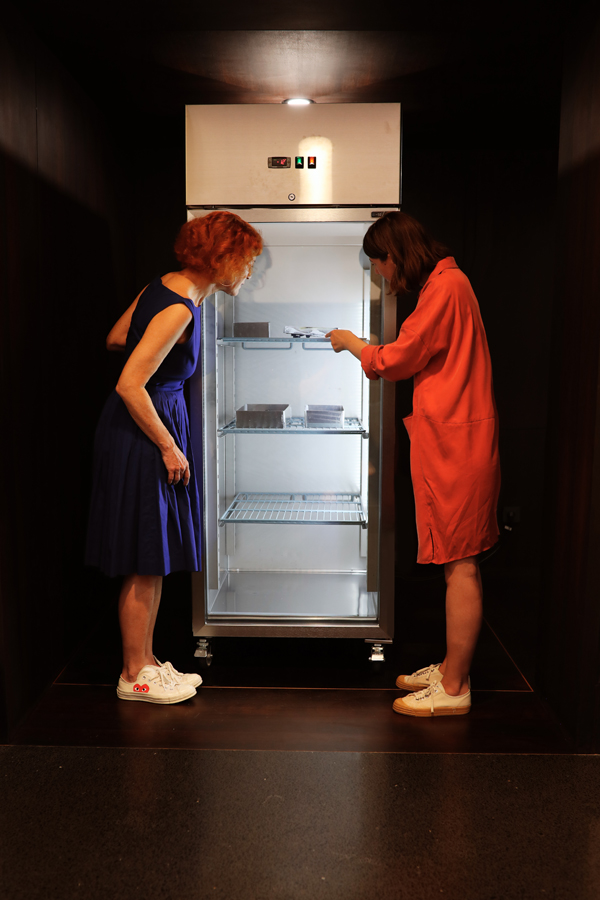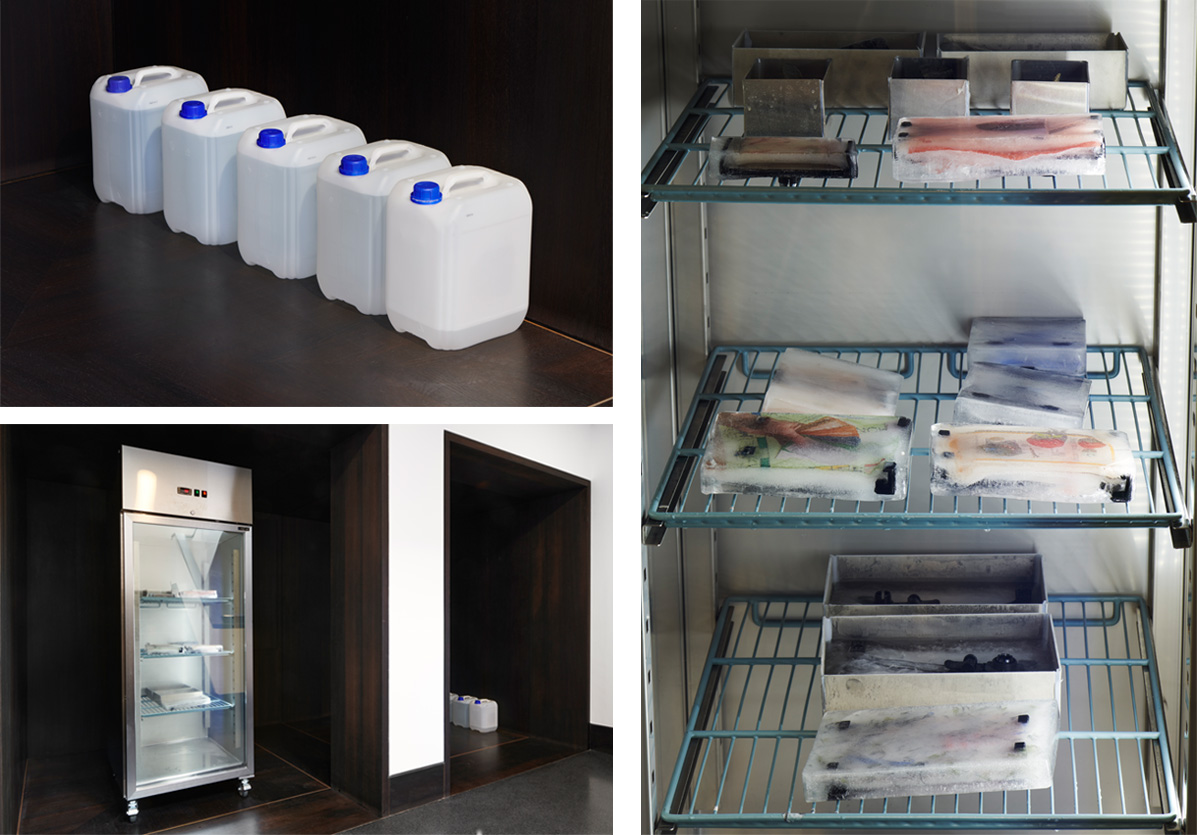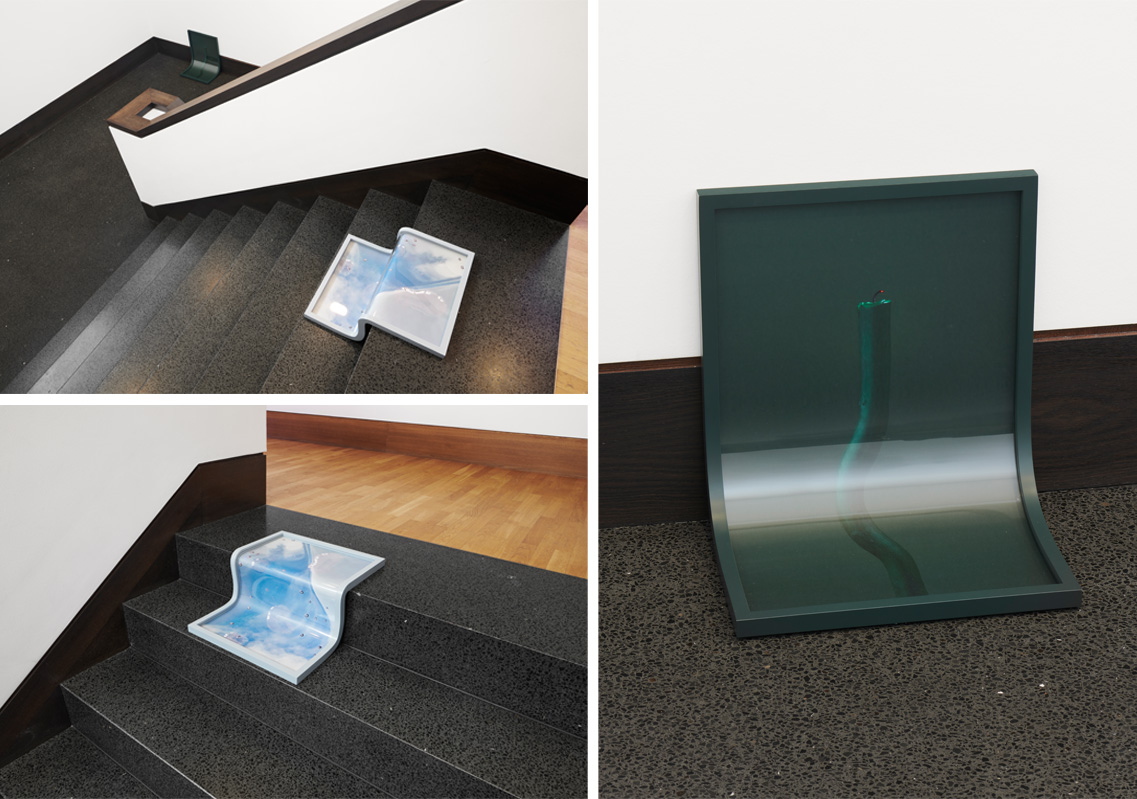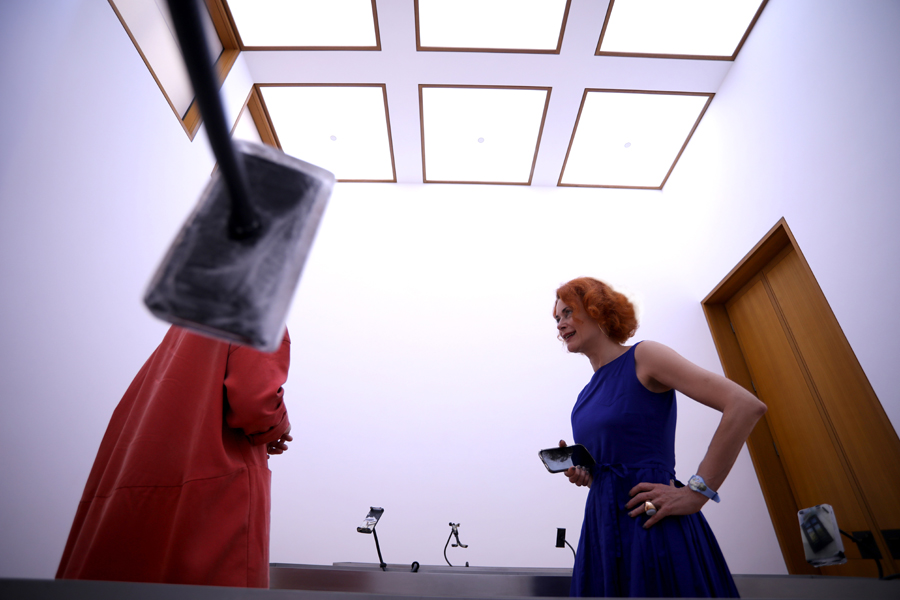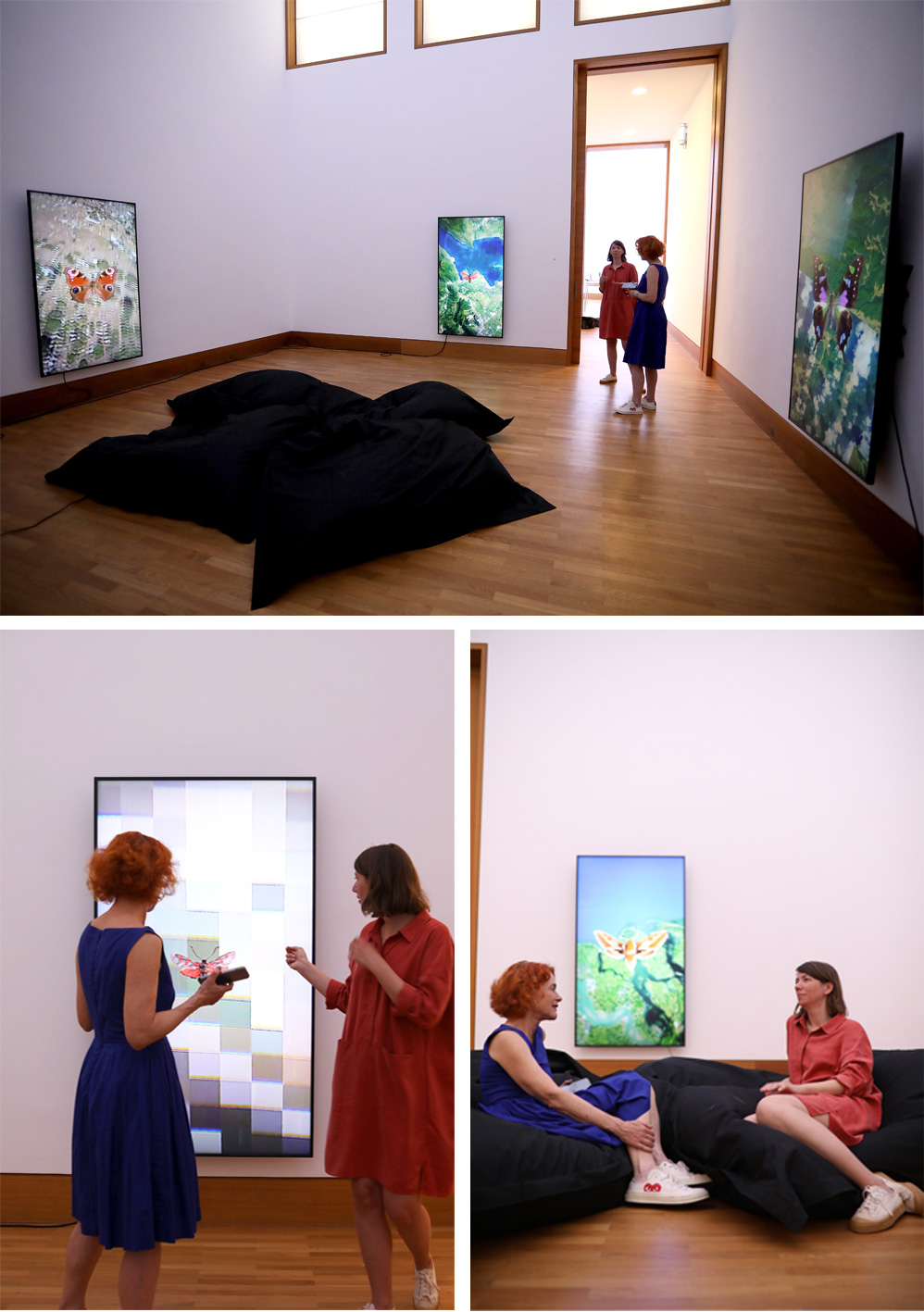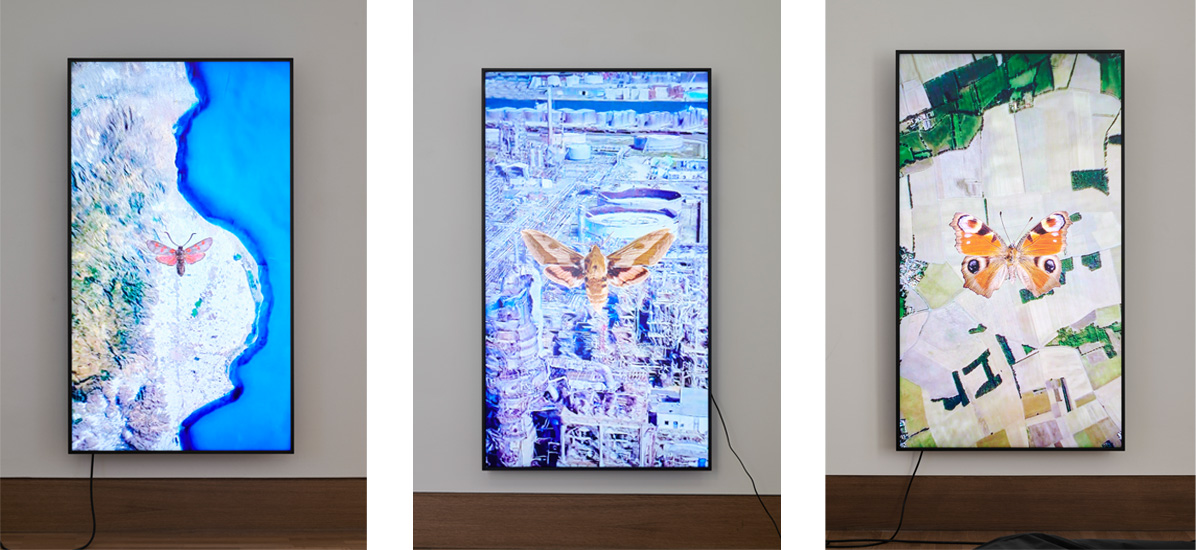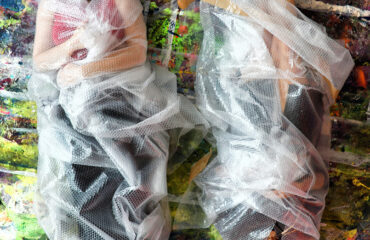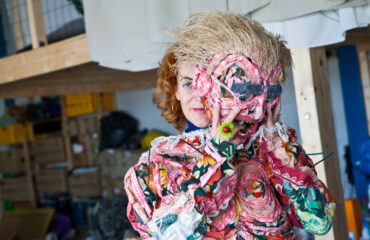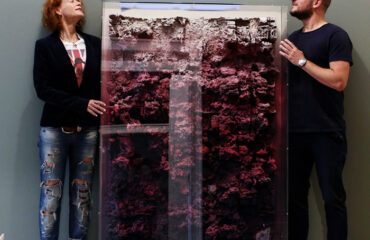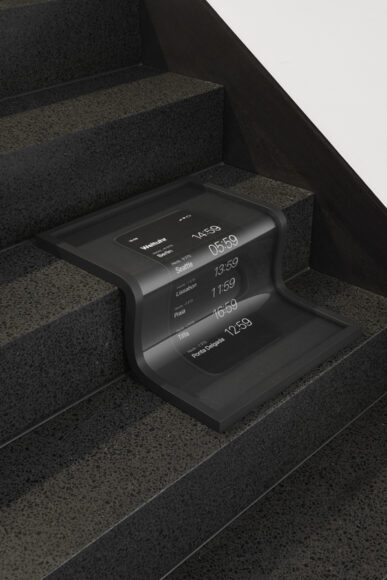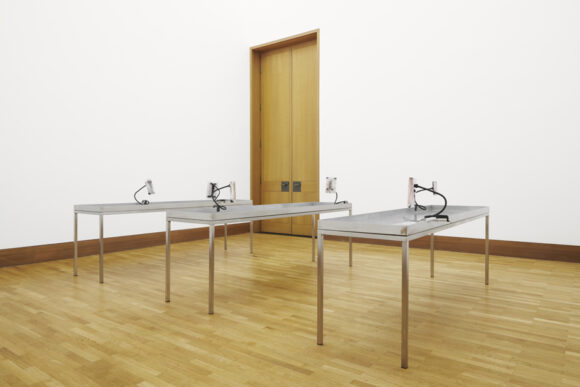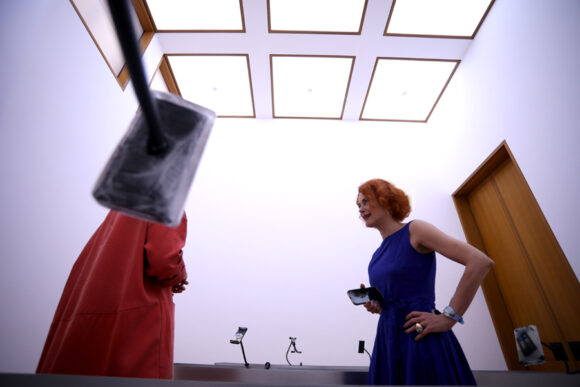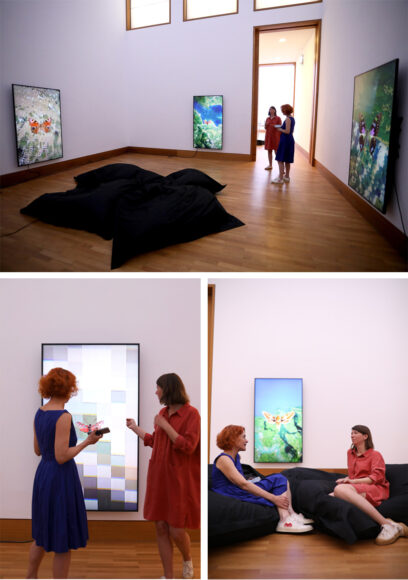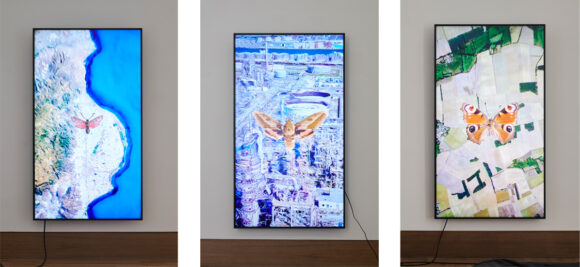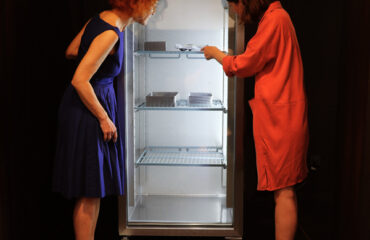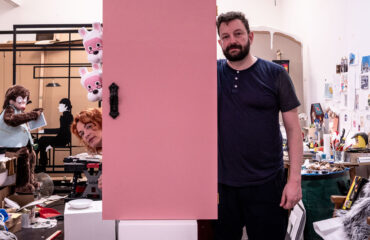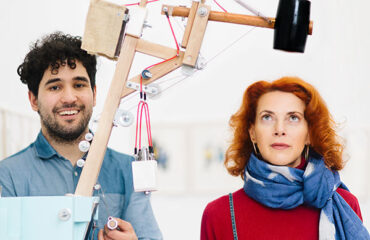Text: Elke Backes, Walkabout-Photos: Natascha Romboy
Cell phone holders, blocks of ice, dissecting tables, frozen matter in a freezer, viscous matter in canisters, photographs in deformed frames, and butterflies on video screens. Although I haven’t seen them, the mere listing makes me more than curious about this exhibition.
How can we connect all of these, such different works? A first idea is conveyed in the exhibition title „d a u e r“. Time obviously plays a decisive role. Alex Grein is a “Meisterschülerin” of Andreas Gursky, so one can assume that everything she does deals with photography. Looking at time in the context of photography seems to be the key.
I am curious and look forward to talking to the artist in the walkabout at Galerie Gisela Clement in Bonn.
The exhibition begins while you are walking up the stairs to the upper gallery level. A photograph displaying time zones snakes on the stairs and seems to move leisurely downward. Time creeping forward at a snail’s pace becomes the image.
d a u e r – Alex Grein, 2021 (Exhibition view at Galerie Gisela Clement, Photos: Mareike Tocha)
On the other hand, the contents of the two exhibition niches, on the first staircase landing, seem out of place. A freezer is on the left and canisters are on the right. Has an event recently taken place here, and hasn’t it been completely cleaned up yet?
“That’s already part of the upper-level installation. I’ll tell you about it shortly,” is Alex Grein’s reaction to my astonished look.
d a u e r – Alex Grein, 2021 (Exhibition views at Galerie Gisela Clement, Photos: Mareike Tocha)
On our way, we cross two more photographs in deformed frames. While the first image of a bent candle gives the impression of having slipped from the wall to the floor, the second one, again curving down the steps, is a photograph of water drops in a cloudy sky, like the reflected view of the skylight.
d a u e r – Alex Grein, 2021 (Exhibition views at Galerie Gisela Clement, Photos: Mareike Tocha)
Time-table, a candle and sky … Three motifs of temporality, spatially extended through deformation, and captured in the stillness of photography. Already, at this point of the walkabout, it makes the exhibition title “d a u e r” pictorial and tangible. This awareness is increased many times over in the first exhibition room …
d a u e r – Alex Grein, 2021 (Exhibition view at Galerie Gisela Clement, Photos: Mareike Tocha)
Dissecting table-like stainless steel tubs with smartphone holders in garishly lighting form an antiseptic, laboratory-like scenery. Armed with a cell phone-sized ice block, Alex Grein enters the room and mounts it on one of the holders. As it thaws, an uncanny process is set in motion. An image becomes visible and successively dissolves. A mixture of ink and decomposing paper drips into the tub, where it develops a viscous mass. The sight of the decomposition process gives me goose bumps. Although it is only an image, the transience of the human body becomes palpable.
Become objective, my inner voice tells me. I bring myself back with the question of the meaning of the image motifs in the installation.
Decomposition process of the frozen image block
Alex Grein: These are photographs from my personal cell phone archive. The significance of the image motifs refer to photography-making as such. For example, this image is a photograph of my display [see above], showing my view out the window, previously taken with my cell phone.
E.B.: Isn’t it a strange feeling to expose these carefully thought-out images to the process of decomposition?
Alex Grein: It was a conscious artistic decision to give up intimacy and step back behind the work.
E.B.: What are the thoughts behind this?
Alex Grein: The work is called “Speicher” and the idea of this installation is to visualize it in photographic terms. For me, the freezer symbolizes the external server room that stores our personal digital image material, which quickly falls into oblivion and is no longer tangible in the flood. By bringing them out of storage, the visible process of decomposition and subsequent archiving in the canisters, I give the digital images a materiality and hereby a meaning that is often lost in the ephemeral nature of digital photography.
All in all then, is it a laboratory against oblivion? Through visualizing the aggregate states, the ephemeral is actually made present in this installation – the classic motif of the memento mori. Exactly the opposite happens at first glance in the next exhibition room …
A more extreme difference to the previous one is hardly imaginable. And this concerns both the spatial situation and the subject. Warm, dimmed light and comfortable seat cushions in the middle of a total of four video screens trigger a feel-good atmosphere. We flatten ourselves into the cushions and look at the images on the screens. While a disproportionately large butterfly remains static in the foreground, various flight events are visible in the background. Butterflies? I suddenly become aware of the symbol of immortality, resurrection and rebirth, and thus the opposite of the ephemeral forms at the center of the action here.
“They are archived specimens of butterflies, many species which are threatened with extinction, I have placed on the display of my Ipad and then filmed” Alex Grein begins her explanations and hereby torpedoes my intended symbolism.
“In the background, Google Earth is running. I start on the virtual globe, zoom in, and then fly to the butterfly’s country of origin – fly it home – so to speak. On the way there, I scroll across the screen and explore the satellite images, which reveal very peculiar surfaces. Areas that, due to human intervention, often no longer map a country by its flora, but by its industrial plants. Often, the images within the areas do not match either, which can ultimately be explained by the different dates of the satellite images. Current and stored images are combined in the temporality of the App.”
d a u e r – Alex Grein, 2021 (Exhibition views at Galerie Gisela Clement, Photos: Mareike Tocha)
E.B.: According to this installation, you find the big theme of life changing on the planet, influenced by industrialization and digitalization through the intervention of man, and which ultimately drives climate change. Do you want to shake things up politically?
Alex Grein: That’s not the main focus for me. But of course it is the topic of our time and it also interests me personal. However, I generally see my artistic challenge placing contemporary issues in the context of photography.
In this exhibition, it is unmistakably time – or more precisely – the perception of time that is “exposed” in the photographic context. In this video work, as well, this confrontation reveals itself in very diverse ways: formally, via the simultaneity of still and moving images; in terms of content, via the constant extinction of animal species due to changes in nature; and ultimately, the distorted representation of temporality through the simultaneous presentation of stored and current data in one image.
The exhibition title “d a u e r” overwrites this perception of time as the big picture connecting all the works in this exhibition and hereby sets the scene for ephemeral in a time characterized by speed and fleetingness …
Must see! On view until August 22 at Galerie Gisela Clement in Bonn.
Further Information
Artist Website: https://www.alexgrein.de
Gallery Website: https://galerie-clement.de
